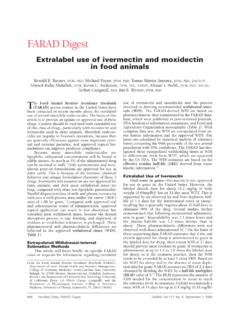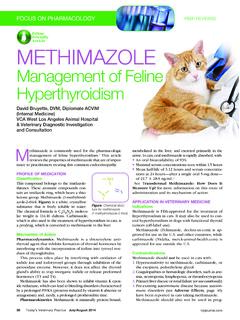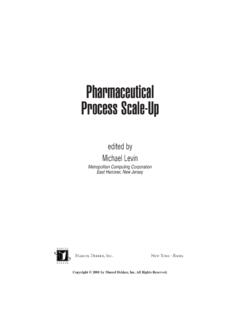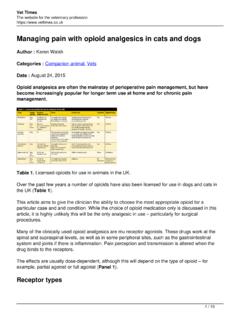Transcription of Egg residue considerations during the treatment of ...
1 1388 Vet Med Today: FARAD Digest JAVMA, Vol 247, No. 12, December 15, 2015In recent years, backyard poultry flocks have be-come increasingly popular in urban areas through-out the United States. Results of a 2010 USDA study1 of 4 US cities (Denver, Los Angeles, Miami, and New York) indicated that 1% of households surveyed owned chickens and another 4% of households sur-veyed were planning on owning chickens within the next 5 years. The increase in the number of small poultry flocks in urban areas has led to an increase in the demand for veterinary services for those flocks, and veterinarians whose clientele is usually limited to companion animals now find themselves treating these food animals and shouldering the responsibili-ties that come with challenges are associated with the treat-ment of backyard poultry flocks.
2 There are a limited number of drugs approved for use in laying hens in the United States, and the few drugs that are approved were designed for administration to birds in large commercial operations, which makes their administration to indi-vidual birds or a small number of birds tedious. Conse-quently, veterinarians often end up administering drugs to backyard poultry in an extralabel manner. Unfortu-nately, the extralabel use of most of those medications is hindered by the availability of only a limited number of pharmacokinetic studies on drug residues in eggs. This is compounded by the fact that owners of back-yard poultry flocks are likely to consider their birds pets and are agreeable to or demand more complex treatment regimens than those traditionally used in commercial flocks.
3 The purpose of the digest reported here is to pro-vide veterinarians with summary background informa-tion on appropriate drug use in modern backyard poul-try flocks. A more in-depth guide2 is available residue considerations during the treatment of backyard poultryFrom the Food Animal residue Avoidance and Depletion Program (FARAD), Department of Medicine and Epidemiology, School of veterinary Medicine, University of California-Davis, Davis, CA 95616 (Marmulak, Tell); FARAD, Institute of Computational Comparative Medicine, College of veterinary Medicine, Kansas State University, Manhattan, KS 66506 (Gehring, Riviere); FARAD, Center for Chemical Toxicology Research and Pharmacokinetics, College of veterinary Medicine, North Carolina State University, Raleigh, NC 27606 (Baynes).
4 And FARAD, Department of Physi-ological Sciences, College of veterinary Medicine, University of Florida, Gainesville, FL 32610 (Vickroy).The generation of this digest was funded by a USDA grant for the Food Animal residue Avoidance and Depletion Program. Address correspondence to Dr. Tell of PoultryThe Poultry Products Inspection Act defines poul-try as any domesticated bird. The USDA interprets that definition as including domestic chickens, turkeys, ducks, geese, and guinea fowl. Major food-producing species of poultry include turkeys and chickens. The US Center for veterinary Medicine, a branch of the FDA, has a list of definitions for the various classes of chickens and turkeys3 (Table 1). Any poultry species not considered a major food-producing species (ie, poultry species other than chickens and turkeys) is by exclusion considered a minor food-producing species of poultry.
5 In this digest, the term poultry is used to refer to any avian species that has the potential for its meat, eggs, offal (ie, internal organs of an animal that are used as food), by-products (ie, feathers), or manure to directly or indirectly enter or influence any portion of the human food of Treating Backyard HensGenerally, eggs produced by the hens of backyard flocks are not subjected to regulatory testing. However, veterinarians need to be cognizant that, according to AMDUCA, any detectable drug residue in the eggs of a hen that was treated with a drug for which a residue tolerance for eggs has not been established by the FDA is a violation. Although drug residues in eggs are not a regulatory issue when those eggs are consumed only by the owner of the treated hen, they can become a li-ability issue if those eggs are sold or given away because it represents entry of an adulterated product into the human food Residues in EggsAnytime a drug is systemically administered to a hen, its ovary, follicles, and oviduct are exposed to that drug , and there is the potential for drug residues in eggs FARAD DigestTara Marmulak, PharmD; Lisa A.
6 Tell, DVM; Ronette Gehring, BVSc, MMedVet; Ronald E. Baynes, DVM, PhD; Thomas W. Vickroy, PhD; Jim E. Riviere, DVM, PhDABBREVIATIONSCPG Compliance policy guideFARAD Food Animal residue Avoidance and Depletion ProgramGFI Guidance for industryMRL Maximum residue limitVFD veterinary feed directiveJAVMA, Vol 247, No. 12, December 15, 2015 Vet Med Today: FARAD Digest 1389produced during the period immediately after drug ad-ministration. Understanding the physiology of egg for-mation is key to understanding how drug residues in eggs hens, follicles undergo 3 phases of development into eggs. Phase 1 follicles, or white follicles, are the smallest follicles; they are immature and contain no Phase 2, or the intermediate stage of egg development, occurs between 6 and 2 weeks before the egg is laid.
7 during this phase, yolk formation is be-gun; egg yolk material (lipoprotein) is formed in the hen s liver and transported in the bloodstream to the ovary where it is deposited within the developing fol-licle. Phase 3 is the final stage of egg development and begins between 14 and 10 days before the egg is laid. during this phase, there is rapid accumulation of yolk lipoproteins, and this phase is believed to be the most important for the deposition of drug residues within the yolk. As the yolk begins to develop, lipoproteins are deposited in a sphere as a series of thin layers or rings, which get subsequently larger and thicker as the follicle matures and the mass of the yolk becomes larger. The rings of lipoprotein deposited around the yolk during phase 3 are the largest and thickest, and if contaminat-ed with a drug , the most likely to contribute to a detect-able drug residue in the egg after it is ,6 Although drug residues are most likely to be detected in eggs that were in phase 3 of follicular development (ie, within 14 days of being laid) when the drug was administered to the hen, it is theoretically possible that any developing eggs that were within 6 weeks of being laid (ie, phase 2 and phase 3 follicles)
8 When a drug was systemically administered to the hen could contain drug of studies6 8 that evaluated residue uptake by eggs in laying hens following administration of am-picillin emphasize the importance of the egg yolk as a deposition site for drug residues. Ampicillin has a short plasma half-life in chickens. Laying hens that received 1 dose of ampicillin (40 mg/kg, IM) had un-detectable plasma concentrations of the drug within 24 hours after administration; however, ampicillin residues were detected in the yolks of the eggs laid by those hens for up to 6 days after drug Because ampicillin is quickly eliminated from plasma, it appears that ampicillin is transported by the circulation to developing follicles (eggs) immediately or shortly after administration and that residues are deposited in the yolks of multiple follicles in the de-velopmental ,8 Given that up to 10% of the hu-man population is allergic to penicillin,9 detection of ampicillin residues in the yolks of eggs for a prolonged period after that short-acting drug is administered to laying hens is sobering.
9 Additionally, detection of am-picillin residues in eggs that were laid when the hen had undetectable plasma concentrations of the drug indicates that once a drug is deposited into the egg yolk it is sequestered there, whereas concentrations of drugs in other tissues generally achieve equilibrium with the blood. Drugs with a plasma half-life that is longer than that of ampicillin or that are stored in tis-sues such as the fat or liver and then subsequently released into the circulation will likely result in egg residues for a longer can also serve as a storage site for drug residues within eggs. In fact, many drugs are preferen-tially deposited in either the albumen or How-ever, because the entire albumen content in an egg is produced within 24 hours after ovulation, the poten-tial for persistent drug residues is less than that for the yolk, which develops over several Drugs for Laying HensAdministration of a drug approved for use in lay-ing hens at the labeled dose and route of administration and adherence to the appropriate withdrawal time is the most practical method for ensuring that eggs produced by treated hens will not contain illegal residues.
10 In the United States, there are currently 8 drugs approved by the FDA for use in laying hens (amprolium, bacitracin, erythromycin, hygromycin B, nystatin, tylosin, nitar-sone, and proparacaine hydrochloride; Table 2).11 All Table 1 Class definitions for chickens and turkeys established by the US Class DefinitionChicken Eggs From in ovo until hatching. Laying hens (layers) Hens that produce eggs for human consumption. Chicks A chicken immediately after hatching until it is able to survive in an ambient- temperature environment (ie, is no longer brooded). Broiler chickens (broilers, Meat-type chickens typically grown to an age of 35 49 d and marketed with fryers, or frying chickens) a weight of approximately kg (4 7 lb). Roasters (roasting chickens) Meat-type chickens marketed with a weight of approximately kg (6 9 lb).












